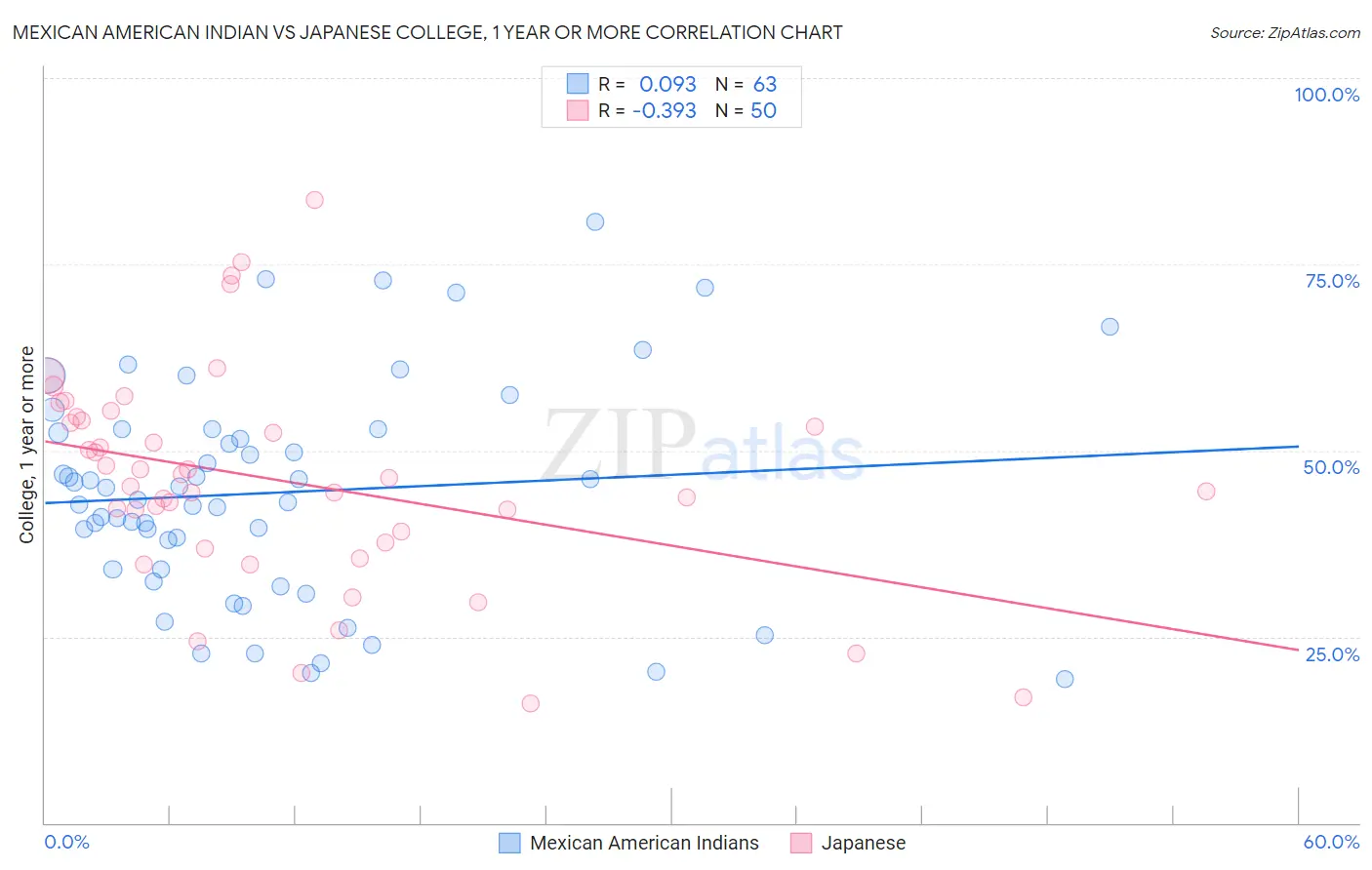Mexican American Indian vs Japanese College, 1 year or more
COMPARE
Mexican American Indian
Japanese
College, 1 year or more
College, 1 year or more Comparison
Mexican American Indians
Japanese
51.9%
COLLEGE, 1 YEAR OR MORE
0.0/ 100
METRIC RATING
306th/ 347
METRIC RANK
55.2%
COLLEGE, 1 YEAR OR MORE
0.5/ 100
METRIC RATING
254th/ 347
METRIC RANK
Mexican American Indian vs Japanese College, 1 year or more Correlation Chart
The statistical analysis conducted on geographies consisting of 317,621,155 people shows a slight positive correlation between the proportion of Mexican American Indians and percentage of population with at least college, 1 year or more education in the United States with a correlation coefficient (R) of 0.093 and weighted average of 51.9%. Similarly, the statistical analysis conducted on geographies consisting of 249,181,552 people shows a mild negative correlation between the proportion of Japanese and percentage of population with at least college, 1 year or more education in the United States with a correlation coefficient (R) of -0.393 and weighted average of 55.2%, a difference of 6.4%.

College, 1 year or more Correlation Summary
| Measurement | Mexican American Indian | Japanese |
| Minimum | 19.3% | 16.1% |
| Maximum | 80.8% | 83.7% |
| Range | 61.4% | 67.6% |
| Mean | 44.3% | 45.9% |
| Median | 43.4% | 45.8% |
| Interquartile 25% (IQ1) | 34.0% | 37.6% |
| Interquartile 75% (IQ3) | 52.8% | 54.1% |
| Interquartile Range (IQR) | 18.8% | 16.5% |
| Standard Deviation (Sample) | 14.6% | 14.4% |
| Standard Deviation (Population) | 14.5% | 14.2% |
Similar Demographics by College, 1 year or more
Demographics Similar to Mexican American Indians by College, 1 year or more
In terms of college, 1 year or more, the demographic groups most similar to Mexican American Indians are Immigrants from Portugal (51.9%, a difference of 0.10%), Salvadoran (51.8%, a difference of 0.20%), Apache (51.8%, a difference of 0.22%), Seminole (52.1%, a difference of 0.33%), and Central American (52.1%, a difference of 0.43%).
| Demographics | Rating | Rank | College, 1 year or more |
| Immigrants | Nicaragua | 0.0 /100 | #299 | Tragic 52.4% |
| Choctaw | 0.0 /100 | #300 | Tragic 52.3% |
| Haitians | 0.0 /100 | #301 | Tragic 52.3% |
| Puerto Ricans | 0.0 /100 | #302 | Tragic 52.2% |
| Creek | 0.0 /100 | #303 | Tragic 52.2% |
| Central Americans | 0.0 /100 | #304 | Tragic 52.1% |
| Seminole | 0.0 /100 | #305 | Tragic 52.1% |
| Mexican American Indians | 0.0 /100 | #306 | Tragic 51.9% |
| Immigrants | Portugal | 0.0 /100 | #307 | Tragic 51.9% |
| Salvadorans | 0.0 /100 | #308 | Tragic 51.8% |
| Apache | 0.0 /100 | #309 | Tragic 51.8% |
| Hondurans | 0.0 /100 | #310 | Tragic 51.6% |
| Immigrants | Haiti | 0.0 /100 | #311 | Tragic 51.5% |
| Pueblo | 0.0 /100 | #312 | Tragic 51.5% |
| Immigrants | Caribbean | 0.0 /100 | #313 | Tragic 51.4% |
Demographics Similar to Japanese by College, 1 year or more
In terms of college, 1 year or more, the demographic groups most similar to Japanese are Immigrants from Bahamas (55.2%, a difference of 0.050%), Immigrants from West Indies (55.2%, a difference of 0.12%), Indonesian (55.1%, a difference of 0.22%), Immigrants from Barbados (55.4%, a difference of 0.25%), and Aleut (55.4%, a difference of 0.36%).
| Demographics | Rating | Rank | College, 1 year or more |
| Hawaiians | 0.8 /100 | #247 | Tragic 55.6% |
| Immigrants | Congo | 0.8 /100 | #248 | Tragic 55.6% |
| Immigrants | Trinidad and Tobago | 0.7 /100 | #249 | Tragic 55.5% |
| Delaware | 0.7 /100 | #250 | Tragic 55.5% |
| Immigrants | Cambodia | 0.6 /100 | #251 | Tragic 55.4% |
| Aleuts | 0.6 /100 | #252 | Tragic 55.4% |
| Immigrants | Barbados | 0.6 /100 | #253 | Tragic 55.4% |
| Japanese | 0.5 /100 | #254 | Tragic 55.2% |
| Immigrants | Bahamas | 0.5 /100 | #255 | Tragic 55.2% |
| Immigrants | West Indies | 0.5 /100 | #256 | Tragic 55.2% |
| Indonesians | 0.4 /100 | #257 | Tragic 55.1% |
| Africans | 0.4 /100 | #258 | Tragic 55.0% |
| Nepalese | 0.3 /100 | #259 | Tragic 54.9% |
| Jamaicans | 0.3 /100 | #260 | Tragic 54.9% |
| Ottawa | 0.3 /100 | #261 | Tragic 54.9% |